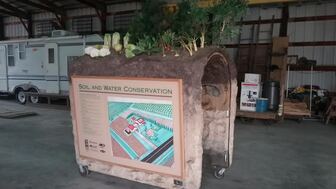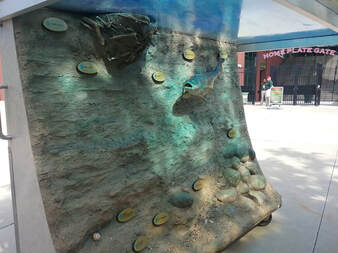About Our Tunnels
The Midland Conservation District owns 2 one-of-a-kind interpretive displays.
The Earth Tunnel and Water Tunnel were built by the generous contributions by the following businesses and organizations: Saginaw Bay "WIN', Design Craftsmen, Midland Cogeneration Venture (MCV), Dow Chemical Company, Midland Conservation District, and Midland County Farm Bureau.
We have two options for using them.
1.) These tunnels are available to rent for your event. The district will transport, set up and present at your event for $200.00 per tunnel per day. All proceeds go to travel costs and maintenance of the trailers.
Trailers must have a hard surface to be displayed on and cannot be used outside during inclement weather.
2.) You can schedule your group or class at our Tomlinson Barn Educational Center.
We have several subjects that we hold educational workshops on. Bring your Group or class to our location.
The Midland Conservation District owns 2 one-of-a-kind interpretive displays.
The Earth Tunnel and Water Tunnel were built by the generous contributions by the following businesses and organizations: Saginaw Bay "WIN', Design Craftsmen, Midland Cogeneration Venture (MCV), Dow Chemical Company, Midland Conservation District, and Midland County Farm Bureau.
We have two options for using them.
1.) These tunnels are available to rent for your event. The district will transport, set up and present at your event for $200.00 per tunnel per day. All proceeds go to travel costs and maintenance of the trailers.
Trailers must have a hard surface to be displayed on and cannot be used outside during inclement weather.
2.) You can schedule your group or class at our Tomlinson Barn Educational Center.
We have several subjects that we hold educational workshops on. Bring your Group or class to our location.
The Earth Tunnel
|
The "Earth Tunnel" is a six-foot long, four-foot wide, five-foot tall enclosed, dome shaped, sand coated structure of sculptured foam and fiberglass for an earthen effect.
The soil profile is detailed in the sand coating on both the exterior and interior of the tunnel. The exterior sides each have an original artwork by Mr. Robert Conway of Saginaw. One-side displays a conservation farm demonstrating current conservation practices used by agricultural producers to manage soil and water. The other side displays a wetland and the ecological benefits of wetlands and their importance. The top of the tunnel is divided in two. One-half is showing a garden of onions, carrots, cauliflower, sugar beets, potatoes, and lettuce from the ground level. The other half is a wetland with swamp grasses, trees, purple loose strife, pond, animals and birds. Inside the tunnel you view the vegetable roots, tree roots, worms, nightcrawlers, grubs, sugar beets, potatoes, three animal burrows (rabbit, snake, mice), a decommissioned well and soil horizons with interpretive panels. This project was made possible by a grant through the Saginaw Bay Watershed Initiative Network ("WIN'). WIN is a volunteer organization that includes more than 90 citizens and focuses on opportunities to better link the economic, social and environmental wellbeing of Saginaw Bay communities in order to sustain and improve the region's quality of life. PURPOSE: The "Earth Tunnel" was created for the Midland County Fair Booth display as well as touring elementary schools for demonstrations. This "Earth Tunnel" visually illustrates the vegetation, insect and animal habitat and a complete soil profile. The "Earth Tunnel" demonstrates how vegetables grow underground, the types of animals that live in underground burrows, and how root systems search for moisture and nutrients. DESCRIPTION: The "Earth Tunnel" was constructed with wood framed Styrofoam walls. The roof was chicken wire attached by plastic connectors to 4 foot long by 6 inches in diameter Styrofoam tubes. The chicken wire was then covered with cloth material. The roof was attached to the wall using 8 inch screws coming up through the top of the wood framed side walls. The Styrofoam cylinders were forced onto the screws, forming the dome shaped roof. The formed tunnel was then sprayed inside and out with foam insulation creating an earthen effect. The tunnel was painted brown inside and out. The outside side wall has a farm scene with farm animals, equipment, a farmer and caricature vegetables attached to the side and also a nature scene with figurines of birds, deer, fish and a fisherman. On one side of the inside, spectators can see rabbit and gopher burrows, complete with earthworms, centipedes, plus a snake and its eggs. The other side demonstrates the soil profile complete with root systems. The roof displayed live trees with roots hanging into the tunnel and vegetable plants such as onions, carrots, and potatoes with the vegetables being viewed from inside the tunnel. Flowers were also inserted into the roof to display their root systems. It gives the effect of walking underneath a forest and a garden. The finishing touches included the tunnel being enclosed with camouflage material with red lighting installed inside adding a mystique atmosphere. |
The Water Tunnel
|
The Water Tunnel is a traveling display that capitalizes on the unique tunnel design by using all surface areas to explain and show water impairments, effects on aquatic life and vegetation, the water cycle, aquatic and terrestrial food chains and biomagnification.
Inside the Water Tunnel from bottom to top including both sides is a gross exaggeration of a polluted stream versus a non-polluted stream. You view a healthy walleye on the good side and bottom feeders, bullhead and catfish on the polluted side, vegetation on one side with little to none on the other side. Spawning beds, caddisflies, snails, beaver lodge, and gravel can be seen on the pristine side with sediment, waterfowl entangled in fishing line, frog trapped in a plastic bottle, erosion, Styrofoam, zebra mussels, bullhead and catfish. Looking up through the water you see a clear blue casting with mayflies, red wing black bird and vegetations and the other side of the tunnel shows a murky casting with mosquitoes, drain tile contamination, slight vegetation and rill and gully erosion. On the outside walls of the Water Tunnel are two graphic panels. One explaining the Terrestrial and Aquatic Food Chains, with definitions of, photosynthesis, herbivores, carnivores, omnivores and how contaminants move up the food chain (bio- magnification), microscopic plants (plankton), periphyton and invertebrates. The other side shows the Water Cycle and how it is a non-renewable resource and how important it is to keep pollutants from our water supply with demonstrations of different ways pollutants reach our water courses, storm sewer runoff, construction, farming, industrial and recreation. "Caution -The Water is Only 60 Inches Deep" in the Water Tunnel and is a learning experience for all. |







